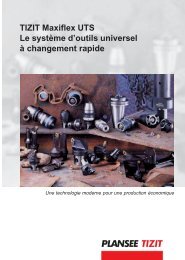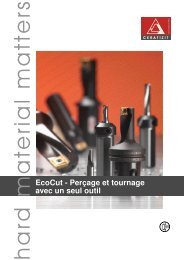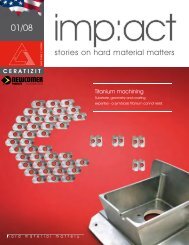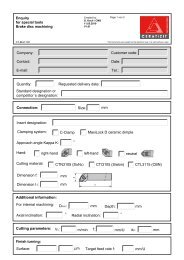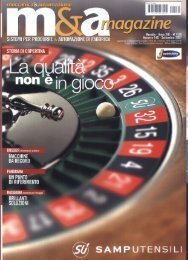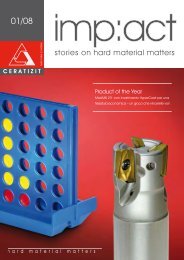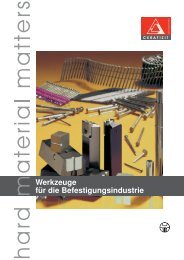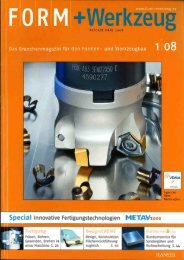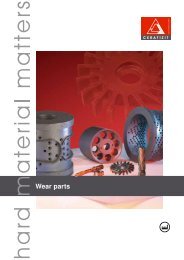stories on hard material matters - Ceratizit S.A.
stories on hard material matters - Ceratizit S.A.
stories on hard material matters - Ceratizit S.A.
Create successful ePaper yourself
Turn your PDF publications into a flip-book with our unique Google optimized e-Paper software.
Interview with Enzo Casanova<br />
Head of Manufacturing Engineering at VM Motori<br />
CERATIZIT: What are the trends in the engine industry?<br />
Casanova: “There are very clear trends towards increased<br />
efficiency and improved performance. An engine<br />
with 150 hp can almost be c<strong>on</strong>sidered a standard<br />
engine and does by no means represent an excepti<strong>on</strong>.<br />
Another tendency is towards engines with smaller<br />
capacity (e.g. 1.5 litres) but high performance.<br />
There is a str<strong>on</strong>g tendency towards the c<strong>on</strong>structi<strong>on</strong> of<br />
engines with low fuel c<strong>on</strong>sumpti<strong>on</strong> which meet the ever<br />
stricter laws <strong>on</strong> exhaust gases. It is a tough job to take all<br />
these factors into account. The electr<strong>on</strong>ics of the engine<br />
are therefore gaining importance as the potential in this<br />
sector is still enormous.”<br />
CERATIZIT: Why did you choose CERATIZIT?<br />
Casanova: “After having looked at some prototypes<br />
we decided to start a test phase with CERATIZIT<br />
products which were not available in batch producti<strong>on</strong><br />
at the time. We firmly believed in the technological and<br />
human potential of CERATIZIT. Now, some m<strong>on</strong>ths after<br />
the tests, we can say that the performance has more<br />
than c<strong>on</strong>firmed our choice.”<br />
CERATIZIT: What are the misc<strong>on</strong>cepti<strong>on</strong>s in the engine<br />
sector?<br />
Casanova: “There are two subjects which come to mind.<br />
First of all, it is often said that Diesel engines are rather<br />
loud and do not run smoothly. This is not really true. In<br />
fact the noise level of an engine depends <strong>on</strong> the way<br />
it is mounted in the car, i.e. how much vibrati<strong>on</strong> is transferred<br />
to the body and how well it has been insulated.<br />
Another misc<strong>on</strong>cepti<strong>on</strong> is that Diesel engines are big<br />
pollutants. Here it must be said that the Diesel engine<br />
has underg<strong>on</strong>e a change: it now has lots of power and,<br />
thanks to innovative technologies, at the same time it is<br />
relatively clean (e.g. Diesel particulate filters).”<br />
CERATIZIT: What are the test procedures for engines at<br />
VM Motori?<br />
Casanova: “All engines run for a few minutes in the<br />
lab in order to check their performance and a certain<br />
percentage of them is subjected to a stricter reliability<br />
test. In the near future a ‘cold test’ will also be introduced<br />
where the engine runs without c<strong>on</strong>suming fuel, thus<br />
making the tests more envir<strong>on</strong>mental-friendly.”<br />
CERATIZIT: Can you give us some basic data <strong>on</strong> the<br />
Diesel engine and its manufacture?<br />
Casanova: “The weight of an automobile engine can<br />
VM MOTORI, ITALY<br />
Enzo Casanova, Head of Manufacturing Engineering at VM Motori.<br />
be between 240 and 280 kilos. The engine itself c<strong>on</strong>sists<br />
of 460 comp<strong>on</strong>ents including small parts such as screws,<br />
clamping pins etc. The assembly of an engine takes<br />
between two and three hours. The guaranteed performance<br />
depends <strong>on</strong> the type of engine and <strong>on</strong> average<br />
this lasts for about 200,000 kilometres.”<br />
CERATIZIT: How strict are the specificati<strong>on</strong>s of the<br />
automotive manufacturers?<br />
Casanova: “The automotive industry requires that<br />
numerous quality assurance measures are carried out<br />
as well as procedures assuring repeatability in batch<br />
producti<strong>on</strong>. Some of these are quality systems like<br />
QS9000 or ISO TS16949. In additi<strong>on</strong> there are customer-<br />
specific requirements to ensure that determined<br />
specificati<strong>on</strong>s are met.”<br />
CERATIZIT: And what does this mean for a company like<br />
VM Motori?<br />
Casanova: “Our customers do not <strong>on</strong>ly demand that<br />
we build and deliver high-performance engines,<br />
but also set up a fully-fledged quality assurance<br />
programme. Qualified employees have to be able to<br />
provide the customer with detailed reports which in case of<br />
problems give an immediate remedy and have to<br />
prove at any time the quality of the batch producti<strong>on</strong><br />
process. It has to be guaranteed to the customer that<br />
everything possible is being d<strong>on</strong>e to not <strong>on</strong>ly guarantee<br />
the product’s quality by analyzing its possible defects<br />
but also through preventive maintenance of all producti<strong>on</strong><br />
plants. Already some eight or nine m<strong>on</strong>ths before<br />
producti<strong>on</strong> starts the customer requires in additi<strong>on</strong> that<br />
the producti<strong>on</strong> capacity is proved with plants operating<br />
at full load, which of course has effects <strong>on</strong> investments.”<br />
41



